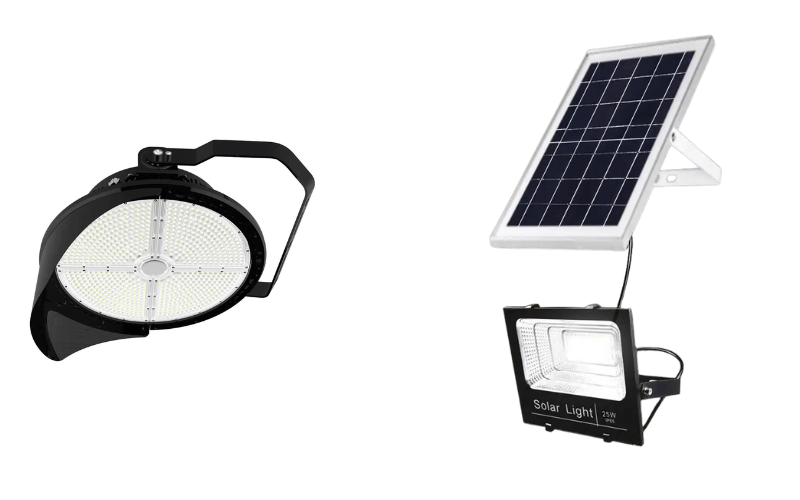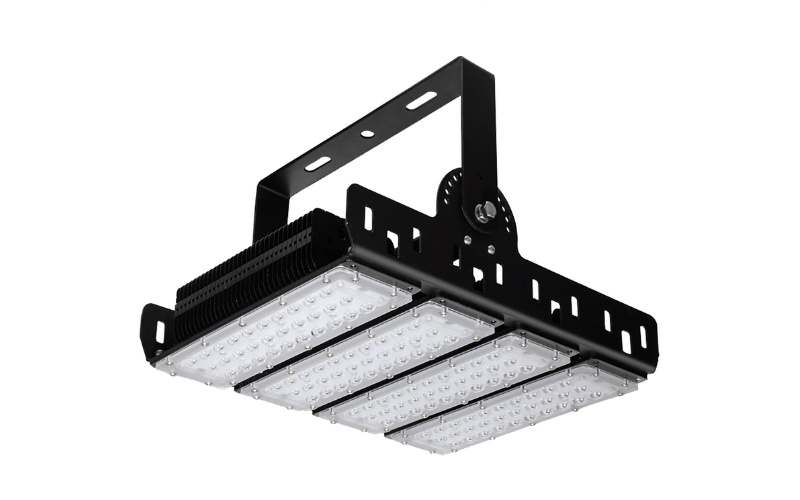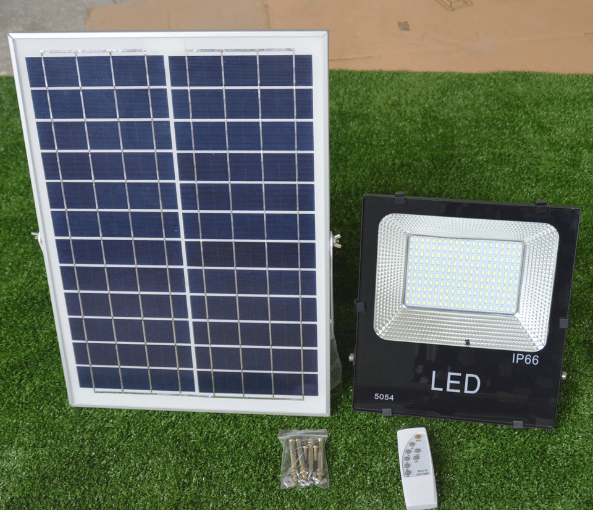When it comes to outdoor lighting, choosing the right floodlight can make all the difference in terms of performance, cost, and environmental impact. Standard LED floodlights and solar LED floodlights each offer unique advantages, catering to different needs and priorities. While standard LED floodlights provide consistent, high-intensity illumination powered by the grid, solar LED floodlights harness renewable energy for a sustainable and cost-effective solution. This guide dives into the features, benefits, and best use cases for both types, helping you make an informed decision tailored to your specific requirements.
Table of Contents
ToggleUnderstanding Standard LED Floodlights
Standard LED floodlights are a popular choice for outdoor lighting, offering powerful illumination and long-lasting performance. They are ideal for areas requiring consistent, high-intensity lighting.
Brightness and Power
- Offer intense, focused beams: Standard LED floodlights are designed to provide bright, concentrated light, making them perfect for illuminating large spaces like parking lots, sports fields, or building exteriors.
- Ideal for security and large areas: Their high brightness levels deter intruders and improve visibility, ensuring safety in both residential and commercial settings.
- Power consumption: typically 10W to 200W: LED floodlights are energy-efficient compared to traditional halogen lights, but their power usage varies depending on the brightness and size of the light.
Installation and Setup
- Requires professional wiring: Unlike solar floodlights, standard LED floodlights need to be connected to your home or building’s electrical system, which often requires an electrician for proper installation.
- Connects directly to your power grid: This ensures consistent performance without relying on weather conditions, making them a reliable option for areas needing uninterrupted lighting.
- Consider accessibility for maintenance: When installing, ensure the lights are placed in locations that are easy to access for cleaning, adjustments, or repairs.
Cost and Maintenance
- Initial purchase cost varies: Prices depend on the wattage, brand, and features of the floodlight, with higher-quality models costing more upfront.
- Ongoing electricity expenses add up: Since these lights draw power from the grid, you’ll need to account for monthly energy costs, especially if they run for extended periods.
- LEDs have a long lifespan: LED bulbs typically last 25,000 to 50,000 hours, reducing the need for frequent replacements compared to traditional bulbs.
- Bulb replacement is infrequent: While rare, replacing an LED bulb is straightforward and cost-effective, further adding to their appeal as a long-term lighting solution.
Standard LED floodlights provide powerful, reliable illumination, making them an excellent choice for large spaces and security-focused applications.
The Rise of Solar LED Floodlights
Solar LED floodlights are revolutionizing outdoor lighting by providing a sustainable, cost-effective, and versatile alternative to traditional options. These lights combine advanced solar technology with practical features, making them a popular choice for both residential and commercial applications. Whether you’re looking to illuminate a backyard, secure a driveway, or light up a remote area, solar floodlights offer a reliable and eco-friendly solution.
Harnessing Sunlight
- Uses solar panels to charge batteries: Solar LED floodlights rely on photovoltaic (PV) panels to capture sunlight and convert it into electricity. High-efficiency monocrystalline panels are particularly effective, charging batteries faster and performing well even in low-light conditions. For example, a 4000mAh battery can fully charge in 6-8 hours of direct sunlight and provide up to 10 hours of illumination.
- No connection to the main power needed: These lights operate independently of the electrical grid, making them ideal for areas where wiring is impractical or unavailable. This feature is especially useful for rural properties, campsites, or temporary setups.
- Perfect for remote locations: Solar floodlights provide reliable illumination in places far from power sources, such as garden sheds, remote storage units, or outdoor event spaces. Their portability and ease of installation make them a go-to option for off-grid lighting needs.
Smart Features and Convenience
- Often include motion sensors: Many solar LED floodlights come equipped with motion detection, activating the light only when movement is detected. This not only conserves battery power but also enhances security by alerting you to activity. For instance, motion sensors can detect movement up to 30 feet away, making them ideal for driveways or entryways.
- Automatic dusk-to-dawn operation: These lights turn on automatically at sunset and off at sunrise, offering hassle-free functionality. This feature ensures consistent lighting without the need for manual adjustments, making them perfect for busy homeowners or commercial spaces.
- Easy to install anywhere: With no wiring required, solar floodlights can be mounted on walls, fences, or poles using basic tools like a screwdriver. Adjustable panels and light heads allow you to direct illumination exactly where it’s needed, whether it’s a garden path or a patio.
Eco-Friendly and Cost-Saving
- Zero electricity costs after purchase: Once installed, solar LED floodlights eliminate energy bills, making them a budget-friendly solution over time. For example, replacing a traditional 150-watt floodlight with a solar-powered one can save up to $50 annually in electricity costs.
- Reduces your carbon footprint: By using renewable solar energy, these lights help decrease reliance on fossil fuels, contributing to a greener planet. A single solar floodlight can prevent the release of approximately 200 pounds of CO2 annually, equivalent to planting two trees.
- “Payback” period can be quick: The initial investment in solar floodlights often pays off within 2-3 years through energy savings. For instance, a $150 solar floodlight can recover its cost by saving $50 per year on electricity.
- Data Point: Solar power can reduce energy bills by up to 100%, making it a smart choice for cost-conscious and eco-conscious users alike.
Solar LED floodlights combine zero electricity costs, easy installation, and eco-friendly operation, making them a practical and sustainable lighting solution for a wide range of applications.
Key Differences: A Direct Comparison
Understanding the key differences between standard and solar floodlights can help you choose the best option for your needs. Here’s a side-by-side look at how they compare in terms of energy, installation, costs, and environmental impact.
Energy Source
- Standard: Grid electricity: Standard floodlights rely on your home or building’s electrical system, ensuring consistent power but adding to your energy consumption.
- Solar: Sunlight: Solar floodlights harness renewable solar energy, storing it in batteries for nighttime use. This eliminates the need for grid power and reduces energy costs.
Installation Complexity
- Standard: Requires electrical work: Installing standard floodlights often involves professional wiring, which can increase both the time and cost of setup.
- Solar: Simple DIY setup: Solar floodlights are easy to install without the need for wiring. You can mount them on walls, fences, or poles with basic tools.
- Expert Insight: “Solar floodlights offer unparalleled flexibility for placement,” notes landscape architect Anya Sharma, highlighting their adaptability for various outdoor spaces.
Long-Term Costs
- Standard: Electricity bills, potential bulb replacement: Standard floodlights incur ongoing energy costs and may require occasional bulb replacements, depending on usage.
- Solar: Initial investment, occasional battery replacement: While solar floodlights have a higher upfront cost, they eliminate electricity bills. Batteries may need replacement every 2-5 years, depending on quality and usage.
Environmental Impact
- Standard: Contributes to energy demand: Standard floodlights rely on grid electricity, which often comes from non-renewable sources, increasing your carbon footprint.
- Solar: Sustainable and renewable: Solar floodlights use clean, renewable energy, making them an eco-friendly choice that helps reduce reliance on fossil fuels.
Choosing between standard and solar floodlights depends on your priorities, such as energy efficiency, installation ease, and environmental impact.
| Feature | Standard LED Floodlights | Solar LED Floodlights |
|---|---|---|
| Energy Source | Grid electricity | Sunlight (solar panels charge batteries) |
| Installation | Requires professional wiring | Simple DIY setup, no wiring needed |
| Cost | Ongoing electricity bills, potential bulb replacement | Higher upfront cost, no electricity bills |
| Maintenance | Infrequent bulb replacement | Occasional battery replacement (every 2-5 years) |
| Environmental Impact | Relies on non-renewable energy sources | Eco-friendly, uses renewable solar energy |
| Best Use Cases | Large spaces needing constant, high-intensity light | Remote areas, eco-conscious and budget-friendly users |
| Examples | Parking lots, sports fields, industrial sites | Backyard patios, garden paths, remote storage units |
When to Choose Which Type
Choosing between standard and solar LED floodlights depends on your specific needs, location, and priorities. Here’s a detailed guide to help you make the right decision.
Best Use Cases for Standard LED Floodlights
- Areas needing constant, high-intensity light: Standard LED floodlights are ideal for spaces that require bright, uninterrupted illumination, such as parking lots or sports fields.
- When consistent power is guaranteed: These lights rely on grid electricity, making them suitable for locations with reliable power access.
- Examples: Car dealerships, large industrial sites, and warehouses benefit from the powerful and steady lighting provided by standard LED floodlights.
Best Use Cases for Solar LED Floodlights
- Areas without easy power access: Solar LED floodlights are perfect for remote locations or outdoor spaces where wiring is impractical or costly.
- For energy savings and eco-consciousness: These lights eliminate electricity costs and reduce your carbon footprint, making them a sustainable choice.
- Examples: Backyard patios, garden paths, and remote storage units are excellent candidates for solar floodlights.
- Case Study: A homeowner installed solar floodlights along their driveway, cutting electricity costs while improving safety and visibility during nighttime hours.
Making Your Decision: Actionable Takeaways
- Assess your power availability: Determine whether the location has easy access to grid electricity or if solar power is a better fit.
- Determine your budget for initial and ongoing costs: Consider the upfront investment and long-term expenses, such as electricity bills or battery replacements.
- Consider the desired brightness and coverage: Match the light’s lumen output and beam angle to your specific lighting needs.
- Think about your environmental goals: If sustainability is a priority, solar floodlights offer a greener alternative.
- Actionable Tip: For security lighting on a budget, start with solar options for perimeter areas to save on installation and energy costs.
Choosing the right floodlight type ensures you get the best performance while meeting your budget and environmental goals.
Frequently Asked Questions
Q: What are the main differences between standard LED floodlights and solar LED floodlights?
A: Standard LED floodlights rely on grid electricity, providing consistent, high-intensity illumination. They require professional wiring and incur ongoing electricity costs. Solar LED floodlights, on the other hand, use sunlight to charge batteries, eliminating electricity bills. They are easy to install, eco-friendly, and ideal for areas without power access.
Q: Which type of floodlight is better for remote locations?
A: Solar LED floodlights are better for remote locations. They operate independently of the power grid, making them perfect for areas where wiring is impractical or unavailable.
Q: Are solar LED floodlights cost-effective in the long run?
A: Yes, solar LED floodlights are cost-effective over time. They eliminate electricity bills and require minimal maintenance. While the initial investment may be higher, the savings on energy costs and the long lifespan of LEDs make them a budget-friendly choice.
Q: Do standard LED floodlights consume a lot of energy?
A: Standard LED floodlights are energy-efficient compared to traditional halogen lights. Their power consumption typically ranges from 10W to 200W, depending on the brightness and size of the light.
Q: How long do solar LED floodlight batteries last?
A: Solar LED floodlight batteries usually last 2-5 years, depending on their quality and usage. Regular maintenance, such as cleaning the solar panels, can help extend battery life.
Q: Can solar LED floodlights work during cloudy days?
A: Yes, solar LED floodlights can work during cloudy days. High-efficiency solar panels can still capture sunlight in low-light conditions, though the charging time may increase.
Q: What are the best use cases for standard LED floodlights?
A: Standard LED floodlights are best for areas needing constant, high-intensity lighting, such as parking lots, sports fields, car dealerships, and industrial sites with reliable power access.
Q: What are the best use cases for solar LED floodlights?
A: Solar LED floodlights are ideal for areas without easy power access, such as backyard patios, garden paths, remote storage units, and campsites. They are also great for eco-conscious users looking to reduce energy costs.
Q: Do solar LED floodlights require professional installation?
A: No, solar LED floodlights do not require professional installation. You can easily mount them on walls, fences, or poles using basic tools, making them a convenient DIY option.
Q: How do motion sensors in solar LED floodlights work?
A: Motion sensors in solar LED floodlights detect movement within a specific range, usually up to 30 feet. When motion is detected, the light activates, conserving battery power and enhancing security.
Concluding Summary
Selecting between standard and solar LED floodlights depends on factors like energy efficiency, installation complexity, long-term costs, and environmental goals. Standard LED floodlights excel in areas requiring constant, high-intensity lighting with reliable power access, while solar LED floodlights shine in remote locations and for eco-conscious users seeking energy savings. By assessing your needs, budget, and priorities, you can choose the floodlight type that delivers optimal performance and value for your space.




